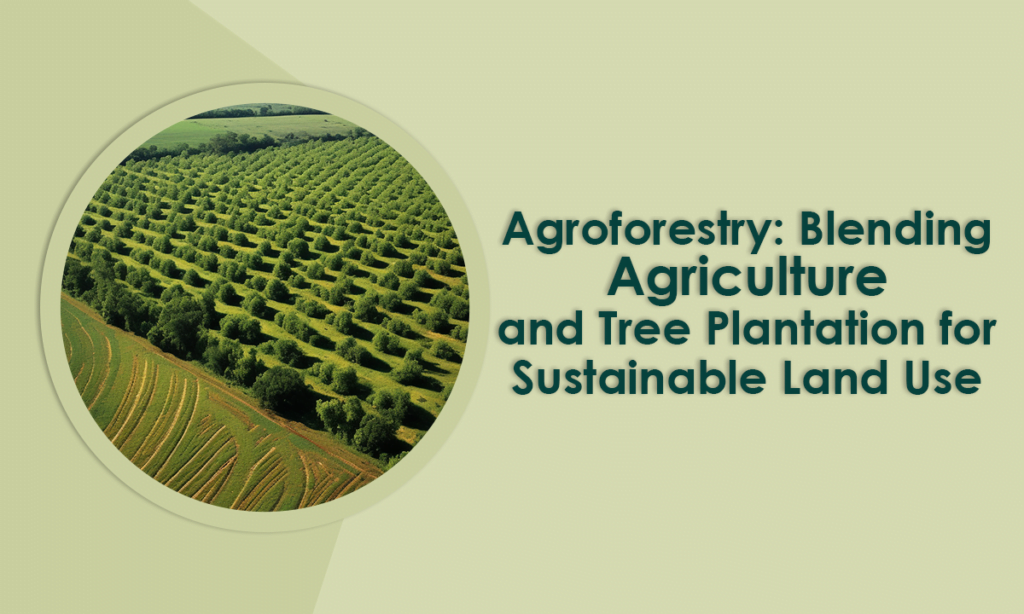Introduction
India’s agricultural landscape has undergone significant transformations over the years, with increasing pressures on land use and natural resources. In response to the growing need for sustainable practices, agroforestry has emerged as a promising solution that integrates agriculture with tree plantation. This innovative approach not only enhances agricultural productivity but also promotes environmental conservation and biodiversity.
In this blog post, we explore the concept of agroforestry from the Indian perspective and its potential in fostering sustainable land use.
The Essence of Agroforestry
Agroforestry is a land-use system that involves the deliberate integration of trees or shrubs with agricultural crops or livestock on the same piece of land. The practice is deeply rooted in India’s traditional farming methods, where trees were an integral part of agricultural landscapes. Through agroforestry, farmers strategically blend different components, optimizing resource use and improving overall ecosystem health.
Advantages of Agroforestry in India
Biodiversity Conservation: Agroforestry systems create diverse habitats, supporting a wide range of plant and animal species. This fosters biodiversity conservation, contributing to the protection of India’s rich ecological heritage.
Soil Health and Erosion Control: Trees in agroforestry systems help prevent soil erosion, enhance soil fertility through nutrient cycling, and retain water, making the land more resilient to climatic variations.
Climate Change Mitigation: Agroforestry acts as a natural carbon sink, sequestering carbon dioxide from the atmosphere and mitigating the impacts of climate change.
Improved Crop Yields: The presence of trees in agroforestry enhances microclimate conditions, providing shade, reducing temperature extremes, and contributing to better crop yields.
Income Diversification: Agroforestry offers farmers multiple income streams, as they can derive revenue from both agricultural crops and tree products like fruits, timber, and non-timber forest products.
Agroforestry Practices in India
India’s diverse agro-climatic zones offer ample opportunities for various agroforestry practices:
Alley Cropping: In this system, rows of trees are planted between rows of agricultural crops, providing shade and organic matter to the soil.
Silvopastoral Systems: Trees are integrated with livestock grazing areas, providing fodder, shade, and windbreaks for animals.
Agri-Horticulture: Combining fruit trees with field crops, allowing for optimal utilization of land and resources.
Homegardens: Small-scale agroforestry systems around homes, providing a mix of fruit trees, vegetables, and medicinal plants.
Government Initiatives and Support
Recognizing the importance of agroforestry, the Indian government has initiated several programs and policies:
National Agroforestry Policy: This policy aims to promote agroforestry practices to enhance agricultural productivity and sustainability.
Mahatma Gandhi National Rural Employment Guarantee Scheme (MGNREGS): Under this scheme, the government supports afforestation and tree planting activities on public lands, empowering local communities.
National Mission for a Green India (GIM): This mission aims to increase forest and tree cover and promote sustainable management of forests.
State-Specific Initiatives: Many Indian states have their agroforestry programs tailored to the region’s specific needs and agro-climatic conditions.
Conclusion
Agroforestry presents a promising pathway to sustainable land use and agricultural development in India. By thoughtfully integrating agriculture and tree plantation, agroforestry maximizes resource use, enhances biodiversity, improves soil health, and contributes to climate change mitigation. Embracing agroforestry not only ensures food security and rural livelihoods but also nurtures a greener and more resilient environment for generations to come. With government support and community participation, agroforestry can truly emerge as a transformative solution, showcasing India’s commitment to sustainable agriculture and environmental stewardship.

Pingback: Community Orchards: Reviving Traditional Farming Practices and Biodiversity - Sankalp Bhoomi Trust
Pingback: The Ethical Responsibility of Giving: Why Donating for the Poor is Crucial - Sankalp Bhoomi Trust